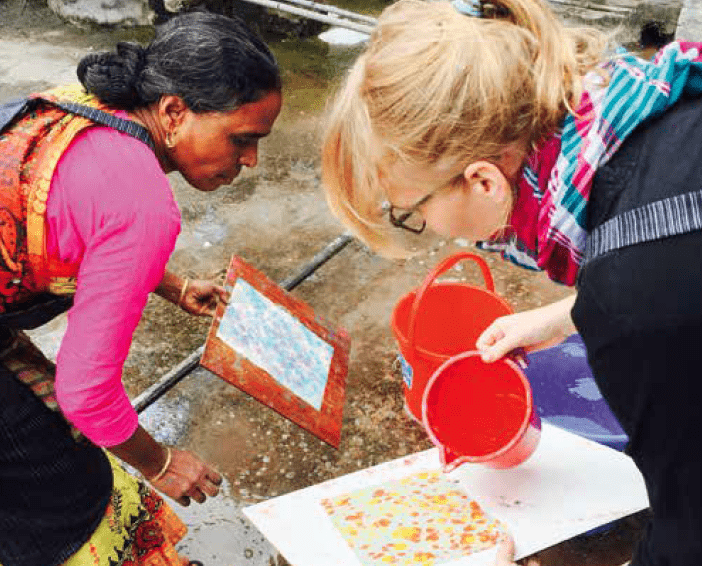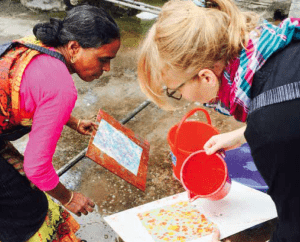By Guest Blogger, Nelleke Schiere
A catalogue not only shows your customers the products you want to sell, it can also tell a lot about your company: how are you structured; what is your capacity; can you keep up with deadlines; and the quality and details of your work. In other words, it is a very important representation and marketing tool for you. You can give it to visitor in print version, share it with buyers, use it as a ‘file’.
For the past two years, I have been working with a Fair Trade organization in Bangladesh and together with the design team, we have learned a lot about developing a catalogue. We hope that these tips can help you as you develop your catalogues too!
INFORMATION
- Arrange your products into logical categories. Let the products or categories tell a story that is interesting to read. For example: in a restaurant menu is arranged by appetizers, main dishes and lastly desserts. Try to find a logical path for your products, even if it is subtle.
- Be sure to add the correct name, code, size and price of product and be consistent in how you do so (both in information and in design).
- Add information (text or picture) about your company, the artisans, the supply chain of the materials, the production process. Highlight aspects that make your product special (for example: you use only recycled materials, all colouring is with natural dyes, you work in a very specific region and with local designs,etc).
- Be sure to provide information about how customers can obtain a physical sample of a product, what are the conditions to order, how and with whom will they communicate about order and payment, etc.
DESIGN
- If you send out seasonal catalogues, make the distinctions visually clear by using different colours, fonts or motives. If you send out yearly catalogues, make it visually clear that is new, and highlight the new products.
- At the same time, be consistent in design and presentation so that customers can know what to expect from your company. While you might use different colours, fonts or motives to distinguish seasonal catalogues, the overall design and aesthetic should be uniform.
- InDesign (Adobe) is the perfect tool to make a digital catalogue. But before creating a digital catalogue, I like to make a paper dummy. Sketch the story, where what should be, how many pages you need and what the general layout should look like. After this step, it is much easier to import your own ideas into a computer software, be it is InDesign, Scribus (an open source desktop publishing application), Powerpoint or even Word or Excel.
- Be aware of the many, many options a software offers. It is tempting to play around and show-off all your tricks, but I find it is best to keep the layout simple and clean. The main subject is your product, the design of the catalogue should support this and not confuse it! Remember to make a low resolution version for sending out a digital version; for printing export your catalogue in high resolution.
- Make your digital catalogue easy to access: send it via mail/ upload it on your website/ send a link. Besides the digital version, print the catalogue to give to customers, friends and to keep in your own archive. Printed versions lay on coffee tables and are sometimes the best ways to promote and show your brand and products, as a digital version stays hidden, ‘inside’ computer.
- It often takes a couple of editions to find a good layout that fits your company, product, story, coding, categories and customer. Every catalogue you send out has to be correct and good, but don’t stress if you can’t find the perfect formula the first time.
PICTURES
- Pictures have to sell your product: they have to be clear, detailed, show different sides of the product or the way the product is used. So take enough time to make good pictures and be critical! Does it really show all aspects of the product? Look at the picture with the eyes of a stranger and decide if the picture is tempting enough to buy the product, just looking at the picture.
- It is fairly simple to make a studio: you need a long piece of white fabric or paper, a rod to hang it to, a table to lay the bottom part on and some (indirect) lights (look online for DIY photo studio for many sizes and variations that fit your needs or possibilities). Avoid shade in the pictures by using natural light or indirect light from different angles. We cover our lights with a piece of fabric so that it is less ‘sharp’.
- It is also nice to make some pictures outside or in the context where your customer uses the product so that s/he can imagine using it. If you go outside, beware of the bright sun: often shady places are best for pictures, the colour of your product and the lighting in the picture.
- For creative pictures, I like to look for inspiration online: how do professionals take pictures of similar products? Simply type into a search engine ‘pictures of …(your product)’ and you get many ideas. If you find an example you like, it is not only helpful for you, but also for your team team: you can show others what you are looking for in a picture and what is needed to make this kind of picture.
COMMUNICATION WITH BUYER
- Ask your main customers when they normally order products. This way, you can make a cycle that fits their schedule or you can let them know in advance when you plan to send your new catalogue so they can consider your products, even though it is out of their own cycle. In all cases, be punctual! This also shows the customer that you take them seriously and that you can handle deadlines (which is also important when they order products).
- Once you have sent out the catalogue, be ready for the next step: do you have samples to send out if your customer wants a physical sample? Is there somebody in your office that knows all about the product and who is ready to respond to emails with questions and requests?



